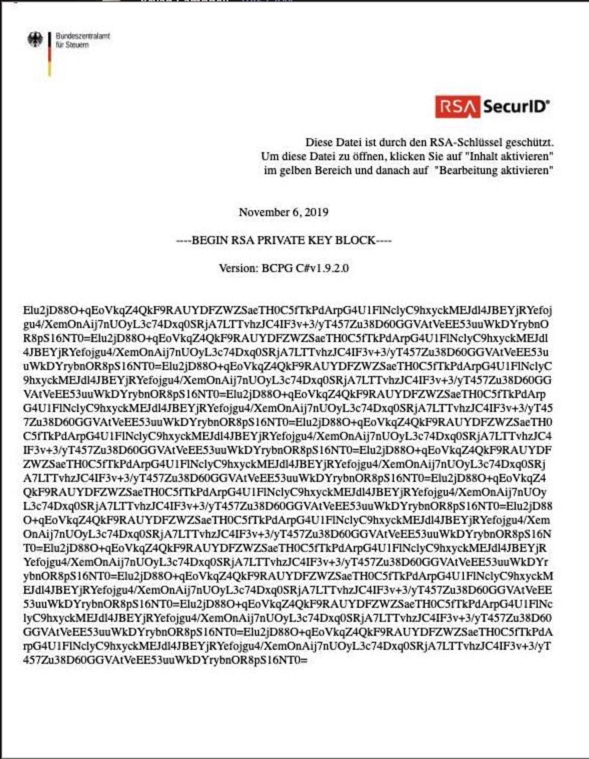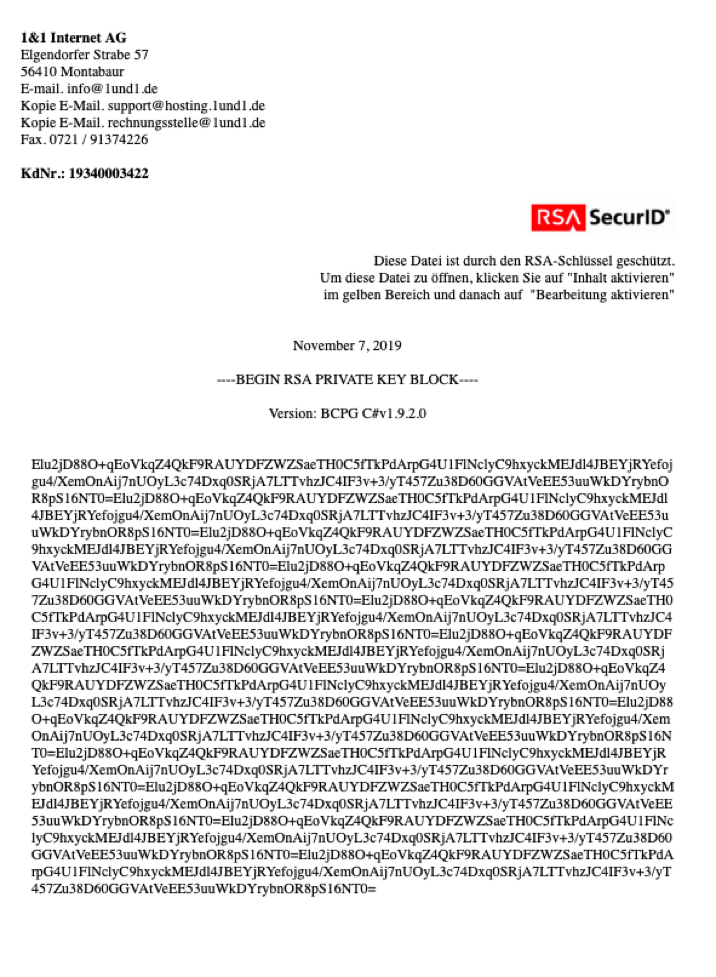Overview
Proofpoint researchers recently detected campaigns from a relatively new actor, tracked internally as TA2101, targeting German companies and organizations to deliver and install backdoor malware.
The actor initiated their campaigns impersonating the Bundeszentralamt fur Steuern, the German Federal Ministry of Finance, with lookalike domains, verbiage, and stolen branding in the emails.
For their campaigns in Germany, the actor chose Cobalt Strike, a commercially licensed software tool that is generally used for penetration testing and emulates the type of backdoor framework used by Metasploit, a similar penetration testing tool.
The product describes itself as “adversary simulation software designed to execute targeted attacks and emulate the post-exploitation actions of advanced threat actors,” and is intended for use by organizations to secure their environments. However, despite its extensive legitimate use as a simulation tool, various actors have deployed and executed campaigns using it as actual malware, including Cobalt Group, APT32, and APT19.
Proofpoint researchers have also observed this actor distributing Maze ransomware, employing similar social engineering techniques to those it uses for Cobalt Strike, while also targeting organizations in Italy and impersonating the Agenzia Delle Entrate, the Italian Revenue Agency. We have also recently observed the actor targeting organizations in the United States using the IcedID banking Trojan while impersonating the United States Postal Service (USPS)
Campaigns
Between October 16 and November 12, 2019, Proofpoint researchers observed the actor sending malicious email messages to organizations in Germany, Italy, and the United States, targeting no particular vertical but with recipients that were heavily weighted towards business and IT services, manufacturing, and healthcare.
October 16 and 23, 2019
On October 16 and 23, Proofpoint researchers observed hundreds of emails attempting to deliver malicious Microsoft Word attachments with German lures impersonating the Bundeszentralamt fur Steuern, the German Federal Ministry of Finance. Of particular note is the use of stolen branding as well as the use of lookalike .icu domains used for the sender email address in order to craft effective lures.
The lure states that a 2019 tax refund is due (“Benachrichtigung über die Steuerrückerstattung”) based on prior returns in the amount of several hundred euros (€694.00 in the observed sample) and that the recipient should submit a refund request (using an attached Microsoft Word document form) within three days for processing. The emails, as part of a low-volume campaign, were targeted primarily at IT services companies.

Figure 1: Email lure sent on October 23, purporting to be from the German Federal Ministry of Finance, notifying the recipient of a tax refund, with a malicious Microsoft Word attachment.
The Microsoft Word attachment, when opened, executes a Microsoft Office macro that, in turn, executes a PowerShell script, which downloads and installs the Maze ransomware payload onto the victim’s system.

Figure 2: A German-language malicious Microsoft Word Attachment that — if the user enables macros — executes a Microsoft Office macro that in turn runs a PowerShell script that downloads Cobalt Strike.
October 29, 2019
On October 29, Proofpoint researchers observed dozens of emails attempting to deliver malicious Microsoft Word attachments with Italian lures impersonating the Agenzia Entrate, the Italian Ministry of Taxation. As with the initially observed German campaign, the actor has used stolen branding as well as lookalike.icu domains used for the sender email address in order to craft effective lures.
The lure appears to be a notification of law enforcement activities (“aggiornamento: attivita di contrasto all'evasione”) and states that the recipient should open and read the enclosed document in order to avoid further tax assessment and penalties.
The emails, as part of a low-volume campaign across multiple verticals, were targeted primarily at manufacturing companies and used an infection chain of Microsoft Office macros into a PowerShell script, which ultimately downloads and installs Maze ransomware.

Figure 3: The email lure sent to Italian organizations is a notification of law enforcement activities, urging the recipient to open and read the enclosed document in order to avoid further tax assessment and penalties.
The malicious document purports to be an RSA SecurID key used by the Italian Ministry of Taxation.

Figure 4: A Microsoft Word attachment in the Italian language, when opened and the user enables macros, executes a Microsoft Office macro that runs a PowerShell script, which in turn downloads and installs the Maze ransomware payload onto the victim’s system.
November 6, 2019
On November 6, 2019, Proofpoint researchers observed hundreds of emails attempting to deliver malicious Microsoft Word attachments with German lures, again impersonating the German Federal Ministry of Finance. As with the previous two campaigns, the actor used stolen branding as well as the use of lookalike .icu domains used for the sender email address in order to craft effective lures. The malicious document purports to be an RSA SecurID key used by the German Ministry of Finance.
The emails, as part of a low-volume campaign, were targeted primarily at business and IT services companies and used the same infection chain outlined for previous campaigns.

Figure 5: A German-language Microsoft Word attachment which, when opened and the user enables macros, executes a Microsoft Office macro that runs a PowerShell script, which in turn downloads and installs the Maze ransomware payload onto the victim’s system.
Opening the Microsoft Word Document and enabling macros installs Maze ransomware on the user’s system, encrypting all of their files, and saves a ransom note resembling the following in TXT format in every directory.

Figure 6: Example ransom notice stored on a victim’s system after their files have been encrypted by Maze ransomware.
November 7, 2019
On November 7, 2019, Proofpoint researchers observed hundreds of emails attempting to deliver malicious Microsoft Word attachments with German lures, this time impersonating a German internet service provider, 1&1 Internet AG.
As with the November 6 campaigns, the actor employed the use of lookalike .icu domains used for the sender email address in order to craft effective lures. The campaign was accompanied by a malicious Microsoft Word attachment with a purported RSA SecurID key, similarly-formatted to the one used in the November 6 campaign.

Figure 7: A German-language Microsoft Word attachment which, when opened and the user enables macros, executes a Microsoft Office macro that launches a PowerShell script, in turn, which downloads and installs the Maze ransomware payload onto the victim’s system.
The emails, as part of a low-volume campaign, were targeted primarily at business and IT services companies, using the same infection chain.
November 12, 2019
On November 12, 2019, Proofpoint researchers observed thousands of emails attempting to deliver malicious Microsoft Word attachments with English lures, this time impersonating the United States Postal Service (USPS) and distributing the IcedID banking Trojan.
The campaign differed from previous European campaigns in that the actor chose a .com lookalike, uspsdelivery-service.com instead of a .icu domain. The campaign was accompanied by a malicious Microsoft Word attachment with a purported RSA SecurID key, similarly-formatted to the one used in the previous campaigns.

Figure 8: An English-language Microsoft Word attachment which, when opened and the user enables macros, executes a Microsoft Office macro that launches a PowerShell script, which in turn downloads and installs the IcedID payload onto the victim’s system.
The emails, as part of a medium-volume campaign, were targeted heavily at the Healthcare vertical, using the same infection chain.
Domain and URL Analysis
Proofpoint researchers have observed a consistent set of TTPs (Tactics, Techniques, and Procedures) that allows attribution of these campaigns to a single actor with high confidence. These include the use of .icu domains, as well as identical email addresses for the Start of Authority (SOA) resource records stored for the DNS entries for the domains used in these campaigns.
Additionally, Proofpoint researchers have observed that the canonical URLs used by this actor are formatted in a repeatable fashion with word_/.tmp in the string with slight variations made over time (included in the IOC section below.) Proofpoint researchers suspect that the word_/.tmp usage might be linked to previous campaigns that were spotted earlier by the infosec community in 2019.
The connection between gladkoff1991@yandex.ru extends beyond the more recent Cobalt Strike campaigns, with references to SOA records from September 2019 “eFax” themed Buran Ransomware campaigns.
German Cobalt Strike/German Tax Office spoof (October 23)
Lure email address: antwortensienicht@bzst-informieren.icu
SOA: gladkoff1991@yandex.ru
Italian Maze Campaign/Italian Ministry of Taxation spoof (October 29)
Lure email address: info@agenziaentrate.icu
SOA: gladkoff1991@yandex.ru
Proofpoint researchers have also determined that the IP address 91.218.114[.]37 is present in all Maze Ransomware downloads initiated by this actor.
German Maze Campaign/German Tax Office spoof (November 6)
This campaign uses an identical lure that was observed on October 23, including the same "RSA Key" malicious Microsoft Word attachment. It is also where we observed the second use of word_/.tmp variation on the URL.
German Maze Campaign/German ISP spoof (November 7)
This campaign, distributing Maze ransomware, impersonates a German internet service provider (1&1 Internet AG) and uses a nearly identical malicious Word Document with an "RSA Key" lure that was observed in the November 6 German Tax Office campaign and the October 23 German campaign using Cobalt Strike.
Lure email address: antwortensienicht@bzstinform.icu
SOA: gladkoff1991@yandex.ru, which matches the October 23 Cobalt Strike campaign.
US IcedID Campaign / USPS Spoof (November 12)
On November 12, Proofpoint researchers observed a campaign utilizing a USPS themed lure delivering the IcedID Trojan. While a .icu domain was not used in this campaign, instead choosing a different look-alike domain, uspsdelivery-service[.]com, these malicious documents used similar “RSA” style lures observed in the previous Cobalt Strike and Maze Ransomware campaigns, and added further evidence to support the theory that the same actor/group is behind the distribution of those malware families.
The SOA for uspsdelivery-service[.]com is gladkoff1991@yandex.ru which matches previous campaigns.
Conclusion
As detailed in Proofpoint’s April 2019 Threat Insight post, Tax-themed Email Campaigns Target 2019 Filers, finance-related lures have been used seasonally with upticks in tax-related malware and phishing campaigns leading up to the annual tax filing deadlines in different geographies. In 2017, these campaigns focused on phishing and increasingly sophisticated social engineering, as well as banking Trojans and ransomware. In 2018, Proofpoint researchers continued to observe sophisticated email campaigns that featured urgent tax-themed lures and convincing spoofs of IRS branding in the United States.
With these new campaigns launched in Germany and Italy utilizing similar urgent tax-assessment and refund lures, Proofpoint researchers have now observed similar spoofs in Europe distributing backdoor Trojans such as Cobalt Strike as well as Maze ransomware. These email spoofs are notable for using convincing stolen branding and lookalike domains of European taxation agencies and other public-facing entities such as Internet service providers. Most recently, the actor has attacked US organizations spoofing the United States Postal Service. The increasing sophistication of these lures mirrors improved social engineering and a focus on effectiveness over quantity appearing in many campaigns globally across the email threat landscape.
References
Indicators of Compromise (IOCs)
|
IOC |
IOC Type |
Description |
|
44991186a56b0d86581f2b9cc915e3af426a322d5c4f43a984e6ea38b81b7bed |
SHA256 |
Document |
|
cfd8e3a47036c4eeeb318117c0c23e126aea95d1774dae37d5b6c3de02bdfc2a |
SHA256 |
Document |
|
9f2139cc7c3fad7f133c26015ed3310981de26d7f1481355806f430f9c97e639 |
SHA256 |
Document |
|
5f1e512d9ab9b915b1fc925f546ed559cbfa49df53229e2f954a1416cf6f5ee4 |
SHA256 |
Document |
|
97043f23defd510607ff43201bb03b9916a23bd71b5bdf97db357e5026732506 |
SHA256 |
Document |
|
d617fd4b2d0824e1a7eb9693c6ec6e71447d501d24653a8e99face12136491a8 |
SHA256 |
Document |
|
7e3ab96d2628e0a9970802b47d0356dc9b99994d7f98492d4e70a5384891695a |
SHA256 |
Document |
|
antowortensienicht@bzst-infomieren[.]icu |
Domain |
Spoofed sending domain |
|
info@agenziaentrate[.]icu |
Domain |
Spoofed sending domain |
|
antwortensienicht@bzstinform[.]icu |
Domain |
Spoofed sending domain |
|
uspsdelivery-service[.[com |
Domain |
Spoofed sending domain |
|
hxxp://198.50.168.67/wordpack.tmp |
Payload |
Cobalt Strike |
|
hxxp://conbase.top/sys.bat |
Payload |
Cobalt Strike |
|
hxxp://104.168.198.208/wordupd.tmp |
Payload |
Maze Ransomware |
|
hxxp://104.168.215.54/wordupd.tmp |
Payload |
Maze Ransomware |
|
hxxp://104.168.174.32/wordupd_3.0.1.tmp |
Payload |
Maze Ransomware |
|
hxxp://192.119.68.225/wordupd1.tmp |
Payload |
Buran Ransomware |
|
hxxp://108.174.199.10/wordupd3.tmp |
Payload |
Buran Ransomware |
|
hxxp://54.39.233.175/wupd19823.tmp |
Payload |
Buran Ransomware |
|
hxxp://54.39.233.131/word1.tmp |
Payload |
Buran Ransomware |
|
hxxp://104.168.198.230/wordupd.tmp |
Payload |
IcedID |
ET and ETPRO Suricata/Snort Signatures
ETPRO TROJAN W32.HTTP.Stager Checkin M1
ET TROJAN Possible Maze Ransomware Activity
ET TROJAN Observed Buran Ransomware UA (BURAN)
ET TROJAN Buran Ransomware Activity M2
ET TROJAN Buran Ransomware Activity M1

